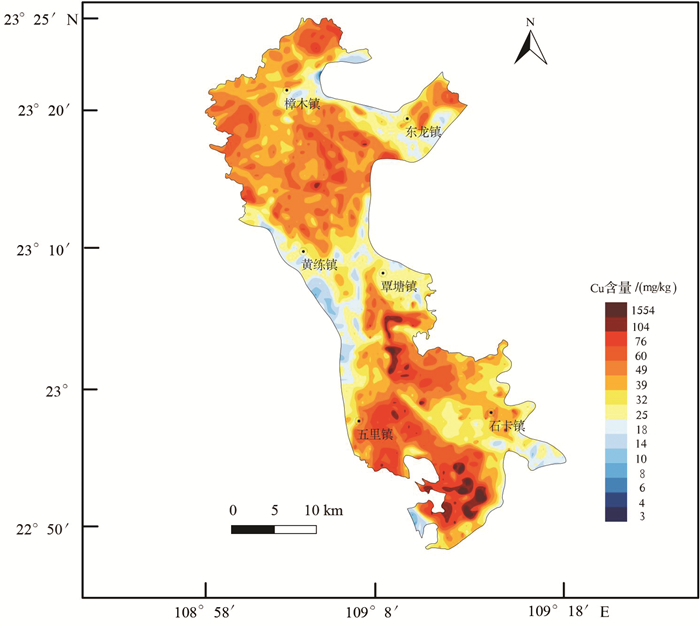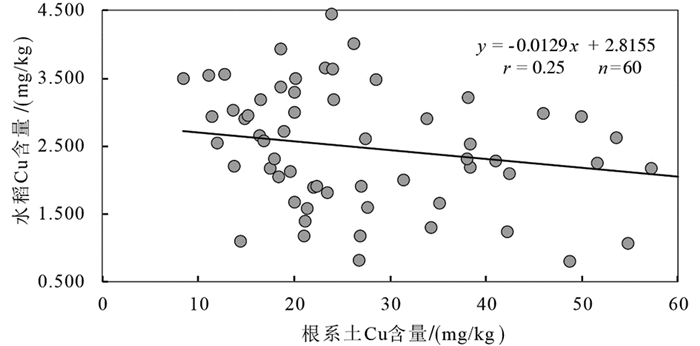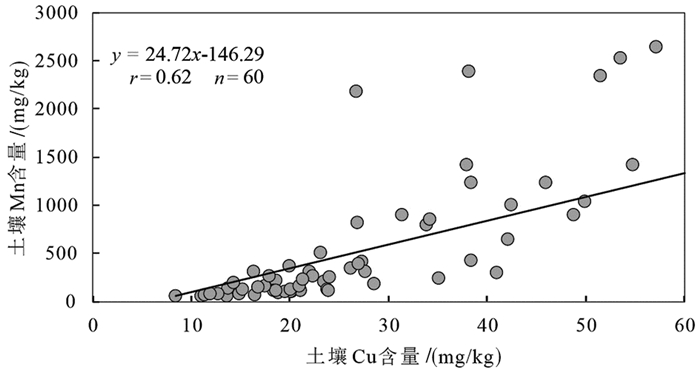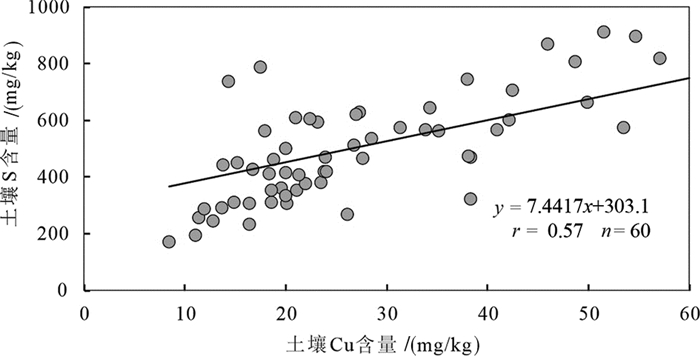Geochemical characteristics of copper in soil of Qintang district, Guigang city, Guangxi and its ecological health research
-
摘要:
研究目的 铜(Cu)是人体必需的微量元素之一,适量摄入Cu十分重要,但缺乏或过量摄入Cu,对人体健康也有损害。因此,通过获知每个人日摄入Cu含量范围,进而确定农产品与土壤的Cu含量最佳范围对保障人体健康至关重要。
研究方法 本文以广西贵港市覃塘区为研究区,依据研究区内居民膳食结构调查结果,以及1∶5万土地质量地球化学调查获取的土壤、农作物及根系土中Cu含量,研究了土壤与水稻籽实中Cu含量特征与空间分布规律,分析了水稻籽实吸收Cu元素的影响因素,研究构建了水稻籽实Cu含量预测模型,推算出研究区内安全开发、种植水稻的土壤Cu含量最佳范围。
研究结果 研究区土壤Cu含量范围为6~74 mg/kg,平均值、中位值分别为28 mg/kg、26 mg/kg,仅有1.6%超过了GB15618中规定的Cu含量风险筛选值,且主要分布在碳酸盐岩出露区,该地区土壤中普遍发育铁锰结核,土壤Cu等重金属生物活性较低。研究区水稻Cu含量范围为0.790~4.440 mg/kg,平均值、中位值为2.452 mg/kg、2.718 mg/kg,60件水稻样品均未超过NY861-2004规定的Cu限量值。
结论 研究区内为保障人体健康、降低生态风险的水稻Cu含量最佳范围为0.615~8.204 mg/kg。研究区内安全开发、种植水稻的土壤Cu含量最佳范围为684 mg/kg。
Abstract:This paper is the result of environmental geological survey engineering.
Objective Copper (Cu) is an essential trace element for humans, while moderate intake of Cu is important, deficiency or overdose of Cu can also be harmful to human health. Therefore, it is important to determine the optimal range of Cu content in agricultural products and soil by knowing the range of daily Cu intake for each person to safeguard human health.
Methods In this paper, taking the Qintang District of the Guigang City of Guangxi as the study area, based on the investigation results of the dietary structure survey of the residents in Guangxi and the Cu content in the soil, crops, and root soil obtained from the 1∶50000 land quality geochemical survey, the characteristics and spatial distribution of Cu content in the soil and rice were studied, the influencing factors of Cu absorption by rice are analyzed. A prediction model for the Cu content of rice was proposed and derived the optimal range of soil Cu content was for the safe development and cultivation of rice in the study area.
Results The results showed that the soil Cu content in the study area ranged from 6~74 mg/kg, with mean and median values of 28 mg/kg and 26 mg/kg, respectively. Only 1.6% exceeded the risk screening value of Cu content specified in GB15618, and it is mainly distributed in the carbonate rock outcropping area. Fe-Mn nodules are widely distributed in this area, and the soil's biological activity of heavy metals such as Cu is relatively low. The range of rice Cu content in the study area is 0.790~4.440 mg/kg; the mean and median values are 2.452 mg/kg and 2.718 mg/kg, and 60 rice samples do not exceed the limit value of Cu specified in NY861- 2004.
Conclusions To protect human health and reduce ecological risks, the optimal range of copper intake in rice is 0.615~8.204 mg/kg. The prediction model of Cu content in rice is established, and it is concluded that the optimal range of safe development of copper in soil and rice cultivation is 6~84 mg/kg.
-

-
表 1 广西城乡居民18岁以上人群各类食物摄入量(g/人日)
Table 1. Food intake of people over 18 years old in urban and rural areas of Guangxi (g/day)

表 2 土壤样品分析方法配套方案
Table 2. Supporting scheme of analytical method for soil
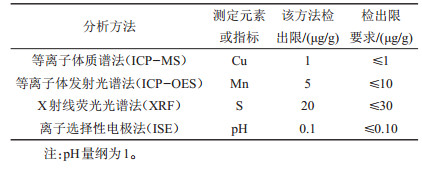
表 3 土壤样品元素全量分析方法准确度和精密度要求
Table 3. Accuracy and precision requirements of analytical method for total elements in soil

表 4 土壤样品元素分析方法准确度和精密度
Table 4. Accuracy and precision of analytical method for elements in soil samples

表 5 农作物样品分析方法配套方案
Table 5. Supporting scheme of analytical method for crop

表 6 农作物样品分析方法准确度和精密度
Table 6. Accuracy and precision of analytical method for elements in crop samples

表 7 土壤Cu污染风险筛选值(mg/kg)
Table 7. Risk screening value of copper pollution in soil (mg/kg)

表 8 富集系数(BAF)与土壤元素相关性(n=60)
Table 8. Correlation analysis of BAF with soil elements(n=60)

-
Adamo P, Iavazzo P, Albanese S, Agrelli D, De Vivo B, Lima A. 2014. Bioavailability and soil-to-plant transfer factors as indicators of potentially toxic element contamination in agricultural soils[J]. Science of the Total Environment, 500-501: 11-22. doi: 10.1016/j.scitotenv.2014.08.085
Amaya E, Gil F, Freire C, Olmedo P, Fernández- Rodríguez M, Fernández M F, Olea N. 2013. Placental concentrations of heavy metals in a mother-child cohort[J]. Environmental Research, 120: 63-70. doi: 10.1016/j.envres.2012.09.009
Branzini A, González R S, Zubillaga M. 2012. Absorption and translocation of copper, zinc and chromium by Sesbania virgata[J]. Journal of Environmental Management, 102: 50-54.
Cao H B, Chen J J, Zhang J, Zhang H, Qiao L, Men Y. 2010. Heavy metals in rice and garden vegetables and their potential health risks to inhabitants in the vicinity of an industrial zone in Jiangsu, China[J]. Journal of Environmental Sciences, 22(11): 1792-1799. doi: 10.1016/S1001-0742(09)60321-1
Chang Yuhu, Zhao Yuanyi, Cao Chong, Shan Yun, Cao Qiang. 2015. Characteristics of heavy metals content and assessment of health risk in different environment media in the dexing copper mining area[J]. Acta Geologica Sinica, 89(5): 889-908 (in Chinese with English abstract).
Cheng Hangxin, Li Kuo, Li Min, Yang Ke, Liu Fei, Cheng Xiaomeng. 2014. Geochemical background and baseline value of chemical elements in urban soil in China[J]. Earth Science Frontiers, 21(3): 265-306 (in Chinese with English abstract).
China National Environmental Monitoring Centre. 1990. Background Values of Soil Elements in China[M]. Beijing: China Environmental Science Press, 86-87 (in Chinese).
Chinese Nutrition Society. 2016. Dietary Guidelines for Chinese[M]. Beijing: People's Medical Publishing House, 3-4 (in Chinese).
Chopra A K, Pathak C. 2015. Accumulation of heavy metals in the vegetables grown in wastewater irrigated areas of Dehradun, India with reference to human health risk[J]. Environmental Monitoring and Assessment, 187(7): 445-454. doi: 10.1007/s10661-015-4648-6
Cui Y J, Zhu Y G, Zhai R H, Chen D Y, Huang Y Z, Qiu Y, Liang J Z. 2004. Transfer of metals from soil to vegetables in an area near a smelter in Nanning, China[J]. Environment International, 30(6): 785-791. doi: 10.1016/j.envint.2004.01.003
Dalcorso G, Manara A, Furini A. 2013. An overview of heavy metal challenge in plants: From roots to shoots[J]. Metallomics, 5(9): 11-17.
D'Amore D V, Stewart S R, Huddleston J H. 2004. Saturation, reduction, and the formation of iron-manganese concretions in the Jackson- Frazier wetland, Oregon[J]. Soil Science Society of America Journal, 68(3): 1012-1022. doi: 10.2136/sssaj2004.1012
De Vries W, McLaughlin M J, Groenenberg J E. 2011. Transfer functions for solid-solution partitioning of cadmium for Australian soils[J]. Environmental Pollution, 159(12): 3583-3594. doi: 10.1016/j.envpol.2011.08.006
Fang Fengman, Wang Linlin, Xie Hongfang, Wang Haidong. 2010. Enrichment characteristic and health risk assessment of heavy metals in vegetables in Sanshan district, Wuhu city, China[J]. Journal of Agro- Environment Science, 29(8): 1471-1476 (in Chinese with English abstract).
Gall J E, Boyd R S, Rajakaruna N. 2015. Transfer of heavy metals through terrestrial food webs: A review[J]. Environmental Monitoring and Assessment, 187(4): 201-222. doi: 10.1007/s10661-015-4436-3
Gao Junquan, Zhang Lei, Li Xiaoqwei. 2004. Dietary intake of copper in China[C]//Abstracts of the Ninth National Nutrition Academic Conference of Chinese Nutrition Society. Beijing (in Chinese).
Gao T, Ke S, Wang S J, Li F B, Liu C S, Lei J, Liao C Z, Wu F. 2018. Contrasting Mg isotopic compositions between Fe- Mn nodules and surrounding soils: Accumulation of light Mg isotopes by Mgdepleted clay minerals and Fe oxides[J]. Geochimica et Cosmochimica Acta, 237: 205-222. doi: 10.1016/j.gca.2018.06.028
Ge Rui. 2019. Geological Characteristics and the Genesis of Touzha Ag- Pb- Zn Deposit, Guigang, Guangxi[D]. Beijing: China University of Geoscience (Beijing), 1-114 (in Chinese with English abstract).
Gong Dongmei, Ru Shuhua, Zhang Guoyin, Wang Ling, Geng Nuan, Sun Shiyou. 2008. Content of heavy metals in soil and vegetables from vegetable land of Yongnian County[J]. Journal of Hebei Agricultural Sciences, 12(7): 88-90, 97 (in Chinese with English abstract).
Gu Jingfan. 2013. Revision of reference intake of dietary nutrients for Chinese residents (3) evolution of RDA and DRI in the United States[J]. Acta Nutrimenta Sinica, 35(1): 11-17 (in Chinese).
Guo Junsheng. 2013. Revision of reference intake of dietary nutrients for Chinese residents (4), Reference intake of dietary nutrients in Japan (2010)[J]. Acta Nutrimenta Sinica, 35(2): 7-12 (in Chinese).
Guo Yunhe, Ding Aizhong, Yu Yanxin. 2017. Health risk assessment of urban population via dietary copper exposure in Le'an river basin[J]. Ecology and Environmental Sciences, 26(7): 1269-1274(in Chinese with English abstract).
Hou S N, Zheng N, Tang L, Ji X F, Li Y Y, Hua X Y. 2019. Pollution characteristics, sources, and health risk assessment of human T exposure to Cu, Zn, Cd and Pb pollution in urban street dust across China between 2009 and 2018[J]. Environment International, 128: 430-437. doi: 10.1016/j.envint.2019.04.046
Kabata-Pendias H A, Mukherjee A B. 2005. Trace Elements from Soil to Human[M]. Berlin: Springer, 282-285.
Li Chunping, Wu Qiqiang. 2013. Geological characteristics and orecontrolling factors of Xiaoping Tianshan Au-Ag-Pb-Zn deposit in Guigang, Guangxi[J]. Mineral Resources and Geology, (3): 37-42 (in Chinese with English abstract).
Liang Xinrong. 2011. A Survey on Nutrition and Health Status of the Old People in Liuzhou City of Guangxi Province[D]. Qingdao: Qingdao University, 1-39 (in Chinese with English abstract).
Liu K, Lü J L, He W X, Zhang H, Cao Y F, Dai Y C. 2015. Major factors influencing cadmium uptake from the soil into wheat plants[J]. Ecotoxicology and Environmental Safety, 113: 207-213. doi: 10.1016/j.ecoenv.2014.12.005
Liu Peng. 2016. The Analysis on the Trend and Influencing Factors of Dietary Patterns of Inhabitants in China——A Research Based on CHNS Data[D]. Taiyuan: Shanxi University of Finance and Economics, 1-89 (in Chinese with English abstract).
Lu Yang, Song Keguan, Huang Zhipeng. 2019. Research progress on the roles of copper- binding proteins in cancer[J]. Anti- Tumor Pharmacy, 9(3): 358-364 (in Chinese with English abstract).
Ma Xudong, Yu Tao, Yang Zhongfang, Zhang Husheng, Wu Zhiliang, Wang Jue, Li Minghui, Lei Fenghua. 2022. Geochemical characteristics of zinc in soil and prediction of zinc content in maize and rice grains in Linshui County, Sichuan Province[J]. Geology in China, 49(1): 324-335 (in Chinese with English abstract).
McBride M B. 2007. Trace metals and sulfur in soils and forage of a chronic wasting disease locus[J]. Environmental Chemistry, 4: 134-139. doi: 10.1071/EN06066
Shi Z M, Ni S J, Zhang C J. 2006. The characteristics of heavy metal enrichment in representative vegetables in chengdu[J]. Earth and Environment, 34(2): 52-55 (in Chinese with English abstract).
Silvia B, Federica P, Carla M C, Janez S, Radmila M, Pamela Z, Bruno C, Paolo Z. 2012. Effects of a copper- deficient diet on the biochemistry, neural morphology and behavior of aged mice[J]. Plos One, 7(10): 1-9.
Su Chuntian, Huang Chenhui, Zou Shengzhang, Luo Fei, Yang Yang, Zhao Guangshuai, Yang Ming. 2017. Transferring features of elements in soil rich in iron- manganese nodules karst area of Litang, Guangxi[J]. Journal of Southern Agriculture, 48(9): 1594-1599 (in Chinese with English abstract).
Sun Lijuan. 2017. Influence of Sulfur Fertilization on Cu Migration and Transformation in Soil and Paddy Rice (Oryza Sativa L. ) System[D]. Hangzhou: Zhejiang University, 1-57 (in Chinese with English abstract).
Tang Jiansheng. 2011. Enrichment Characteristics and Poison Research to Crops of Heavy Metals in Fe- Mn Nodules Soil in Karst Area of Guangxi Central[D]. Beijing: China University of Geoscience (Beijing), 1-114 (in Chinese with English abstract).
Tang Mengquan, Huang Jiahuan, Chen Jinyuan, Wang Qi, Xu Zhiru. 2019. Research progress on copper homeostasis in plants: A review[J]. Jiangsu Agricultural Sciences, 47(10): 305-311 (in Chinese with English abstract).
Tang Zhenzhu. 2019. Investigation Report on Dietary Nutrition of Guangxi Residents (2010-2015)[M]. Nanning: Guangxi People's Publishing House, 1-20(in Chinese).
Tóth G, Hermann T, Da Silva M R, Montanarella L. 2016. Heavy metals in agricultural soils of the European Union with implications for food safety[J]. Environment International, 88: 299-309. doi: 10.1016/j.envint.2015.12.017
Weber F A, Voegelin A, Kretzschmar R. 2009. Multi- metal contaminant dynamics in temporarily flooded soil under sulfate limitation[J]. Geochimica et Cosmochimica Acta, 73(19): 5513-5527. doi: 10.1016/j.gca.2009.06.011
Xiao Fei, Wang Chaoxu, Yang Li. 2013. Effects of copper deficiency on iron metabolism in rats[J]. Journal of Hygiene Research, (4): 652-655 (in Chinese with English abstract).
Xu F, Giovanoulis G, van Waes S, Padilla-Sanchez J A, Papadopoulou E, Magnér J, Haug L S, Neels H, Covaci A. 2016. Comprehensive study of human external exposure to organophosphate flame retardants via air, dust, and hand wipes: The importance of sampling and assessment strategy[J]. Environmental Science and Technology, 50(14), 7752-7760. doi: 10.1021/acs.est.6b00246
Xu Pei, Wu Chao, Qiu Guanhao. 2015. Study on the law of soil heavy metals pollution around lead- zinc mining areas in China[J]. Chinese Journal of Soil Science, 46(3): 233-238 (in Chinese with English abstract).
Yang Yuexin. 2009. China Food Composition[M]. Beijing: Peking University Medical Press, 3-13 (in Chinese with English abstract).
Yousaf B, Amina, Liu G J, Wang R W, Imtiaz M, Rizwan M S, Ziaur- Rehman M, Qadir A, Si Y B. 2016. The importance of evaluating metal exposure and predicting human health risks in urban-periurban environments influenced by emerging industry[J]. Chemosphere, 150: 79-89. doi: 10.1016/j.chemosphere.2016.02.007
Zeng F R, Ali S, Zhang H T, Ouyang Y N, Qiu B Y, Wu F B, Zhang G P. 2011. The influence of pH and organic matter content in paddy soil on heavy metal availability and their uptake by rice plants[J]. Environmental Pollution, 159(1): 84-91. doi: 10.1016/j.envpol.2010.09.019
Zhang J R, Li H Z, Zhou Y Z, Dou L, Cai L M, Mo L P, You J. 2018. Bioavailability and soil- to- crop transfer of heavy metals in farmland soils: A case study in the Pearl River Delta, South China[J]. Environmental Pollution, 235: 710-719. doi: 10.1016/j.envpol.2017.12.106
Zhang M M, Lu X W, Chen H, Gao P P, Fu Y. 2015. Multi-element characterization and source identification of trace metal in road dust from an industrial city in semi- humid area of Northwest China[J]. Journal of Radioanalytical and Nuclear Chemistry, 303: 637-646. doi: 10.1007/s10967-014-3300-1
Zhong Jie. 2013. Discussion on rice production development in Guangxi[J]. Journal of Guangxi Agriculture, 28(5): 44-47 (in Chinese).
Zhuang P, Mcbride M B, Xia H P, Li N Y, Li Z A. 2009. Health risk from heavy metals via consumption of food crops in the vicinity of Dabaoshan mine, South China[J]. Science of the Total Environment, 407(5): 1551-1561. doi: 10.1016/j.scitotenv.2008.10.061
常玉虎, 赵元艺, 曹冲, 单云, 曹强. 2015. 德兴Cu矿区主要流域内环境介质中重金属含量特征与健康风险评价[J]. 地质学报, 89(5): 889-908. https://www.cnki.com.cn/Article/CJFDTOTAL-DZXE201505005.htm
成杭新, 李括, 李敏, 杨柯, 刘飞, 成晓梦. 2014. 中国城市土壤化学元素的背景值与基准值[J]. 地学前缘, 21(3): 265-306. https://www.cnki.com.cn/Article/CJFDTOTAL-DXQY201403035.htm
方凤满, 汪琳琳, 谢宏芳, 王海东. 2010. 芜湖市三山区蔬菜中重金属富集特征及健康风险评价[J]. 农业环境科学学报, 29(8): 1471-1476. https://www.cnki.com.cn/Article/CJFDTOTAL-NHBH201008010.htm
高俊全, 张磊, 李筱薇. 2004. 中国人Cu的膳食摄入量现状[C]. 中国营养学会第九次全国营养学术会议论文摘要汇编. 北京.
葛锐. 2019. 广西贵港市头闸银铅锌矿床地质特征和成因研究[D]. 北京: 中国地质大学(北京), 1-114.
贡冬梅, 茹淑华, 张国印, 王凌, 耿暖, 孙世友. 2008. 永年县典型蔬菜田土壤和蔬菜重金属含量状况研究[J]. 河北农业科学, 12(7): 88-90, 97. https://www.cnki.com.cn/Article/CJFDTOTAL-HBKO200807036.htm
顾景范. 2013. 《中国居民膳食营养素参考摄入量》修订(三) 美国RDA与DRI的演变[J]. 营养学报, 35(1): 11-17. https://www.cnki.com.cn/Article/CJFDTOTAL-YYXX201301001.htm
郭俊生. 2013. 《中国居民膳食营养素参考摄入量》修订(四) 日本膳食营养素参考摄入量(2010)[J]. 营养学报, 35(2): 7-12. https://www.cnki.com.cn/Article/CJFDTOTAL-YYXX201302005.htm
郭云鹤, 丁爱中, 于艳新. 2017. 乐安河流域城市人群Cu膳食暴露及健康风险[J]. 生态环境学报, 26(7): 1269-1274. https://www.cnki.com.cn/Article/CJFDTOTAL-TRYJ201707026.htm
李春平, 吴启强. 2013. 广西贵港小平天山金银铅锌矿床地质特征及控矿因素分析[J]. 矿产与地质, (3): 37-42. https://www.cnki.com.cn/Article/CJFDTOTAL-KCYD201303006.htm
梁新蓉. 2011. 广西柳州社区老年人营养与健康状况调查研究[D]. 青岛: 青岛大学, 1-39.
刘鹏. 2016. 我国居民膳食结构变化趋势及影响因素分析——基于CHNS数据库的研究[D]. 太原: 山西财经大学, 1-89.
卢阳, 宋科官, 黄志鹏. 2019. Cu结合蛋白在癌症中作用的研究进展[J]. 肿瘤药学, 9(3): 358-364. https://www.cnki.com.cn/Article/CJFDTOTAL-LIYX201903003.htm
马旭东, 余涛, 杨忠芳, 张虎生, 武芝亮, 王珏, 李明辉, 雷风华. 2022. 四川省邻水县土壤锌地球化学特征及玉米水稻籽实锌含量预测[J]. 中国地质, 49(1): 324-335. http://geochina.cgs.gov.cn/geochina/article/abstract/20220121?st=article_issue
施泽明, 倪师军, 张成江. 2006. 成都城郊典型蔬菜中重金属元素的富集特征[J]. 地球与环境, 34(2): 52-55. https://www.cnki.com.cn/Article/CJFDTOTAL-DZDQ200602007.htm
苏春田, 晨晖, 邹胜章, 罗飞, 杨杨, 赵光帅, 阳明. 2017. 广西黎塘岩溶区富含铁锰结核土元素迁移特征[J]. 南方农业学报, 48(9): 1594-1599. https://www.cnki.com.cn/Article/CJFDTOTAL-GXNY201709010.htm
孙丽娟. 2017. 硫肥对土壤——水稻系统Cu迁移转化的影响及作用机制[D]. 杭州: 浙江大学, 1-157.
唐建生. 2011. 桂中岩溶区铁锰结核土的重金属富积特征及对旱地作物毒害研究[D]. 北京: 中国地质大学(北京), 1-114.
唐孟泉, 黄佳欢, 陈瑾元, 王琪, 许志茹. 2019. 植物的Cu稳态研究综述[J]. 江苏农业科学, 47(10): 305-311. https://www.cnki.com.cn/Article/CJFDTOTAL-JSNY201910067.htm
唐振柱. 2019. 广西居民膳食营养调查报告(2010-2015)[M]. 南宁: 广西人民出版社, 1-20.
肖飞, 王朝旭, 杨丽. 2013. Cu缺乏对大鼠铁代谢的影响[J]. 卫生研究, (4): 652-655. https://www.cnki.com.cn/Article/CJFDTOTAL-WSYJ201304028.htm
徐佩, 吴超, 邱冠豪. 2015. 我国铅锌矿山土壤重金属污染规律研究[J]. 土壤通报, 46(3): 233-238. https://www.cnki.com.cn/Article/CJFDTOTAL-TRTB201503037.htm
中国环境监测总站. 1990. 中国土壤元素背景值[M]. 北京: 中国环境科学出版社, 86-87.
中国营养学会. 2016. 中国居民膳食指南[M]. 北京: 人民卫生出版社, 3-4.
钟洁. 2013. 浅谈广西水稻生产发展[J]. 广西农学报, 28(5): 44-47. https://www.cnki.com.cn/Article/CJFDTOTAL-GXLB201305013.htm
-



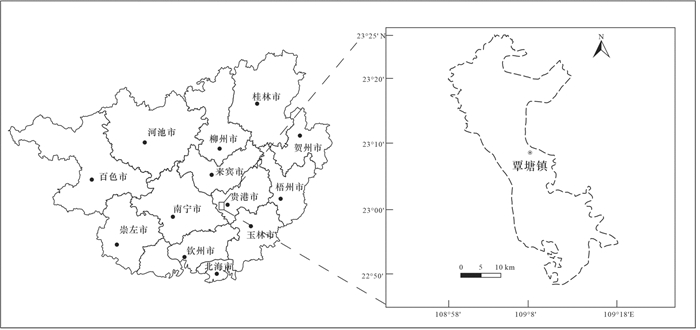
 下载:
下载:
